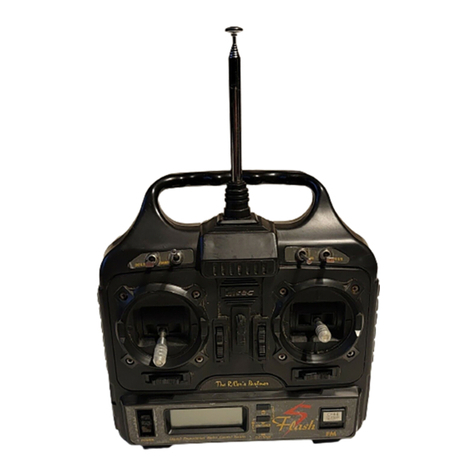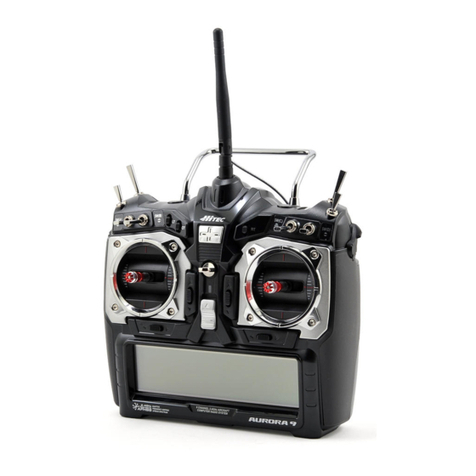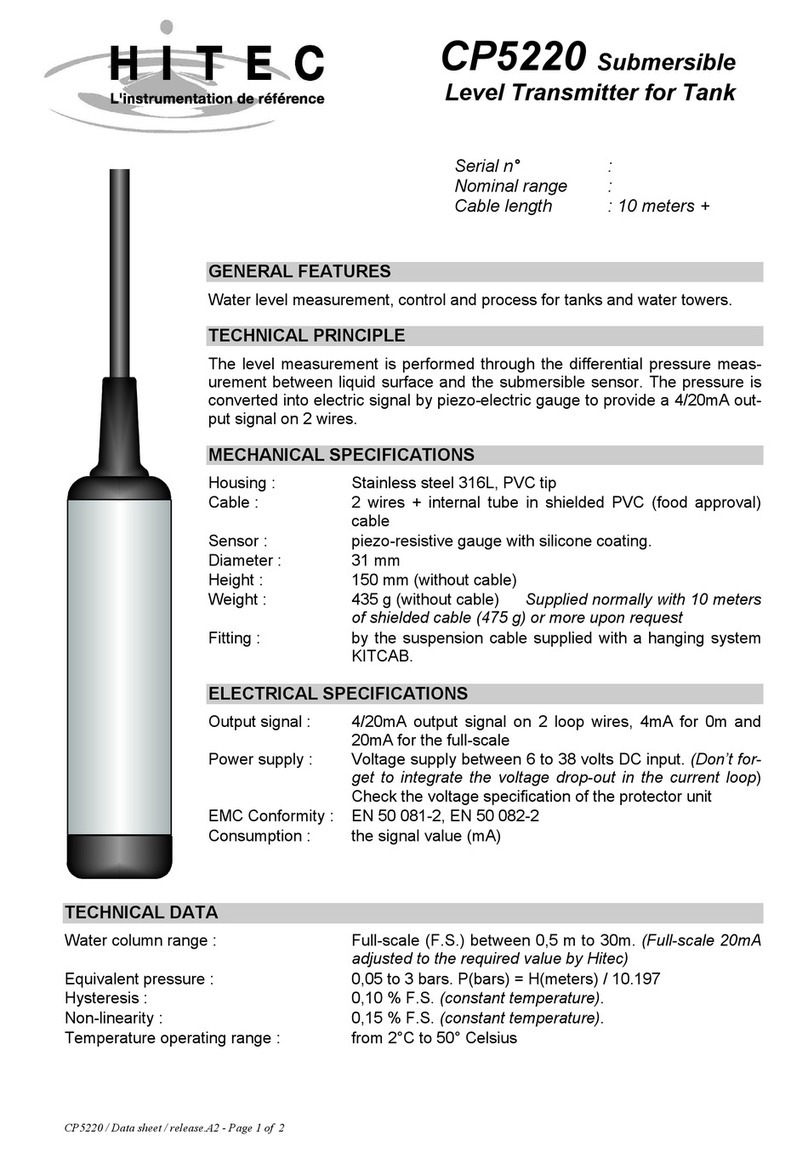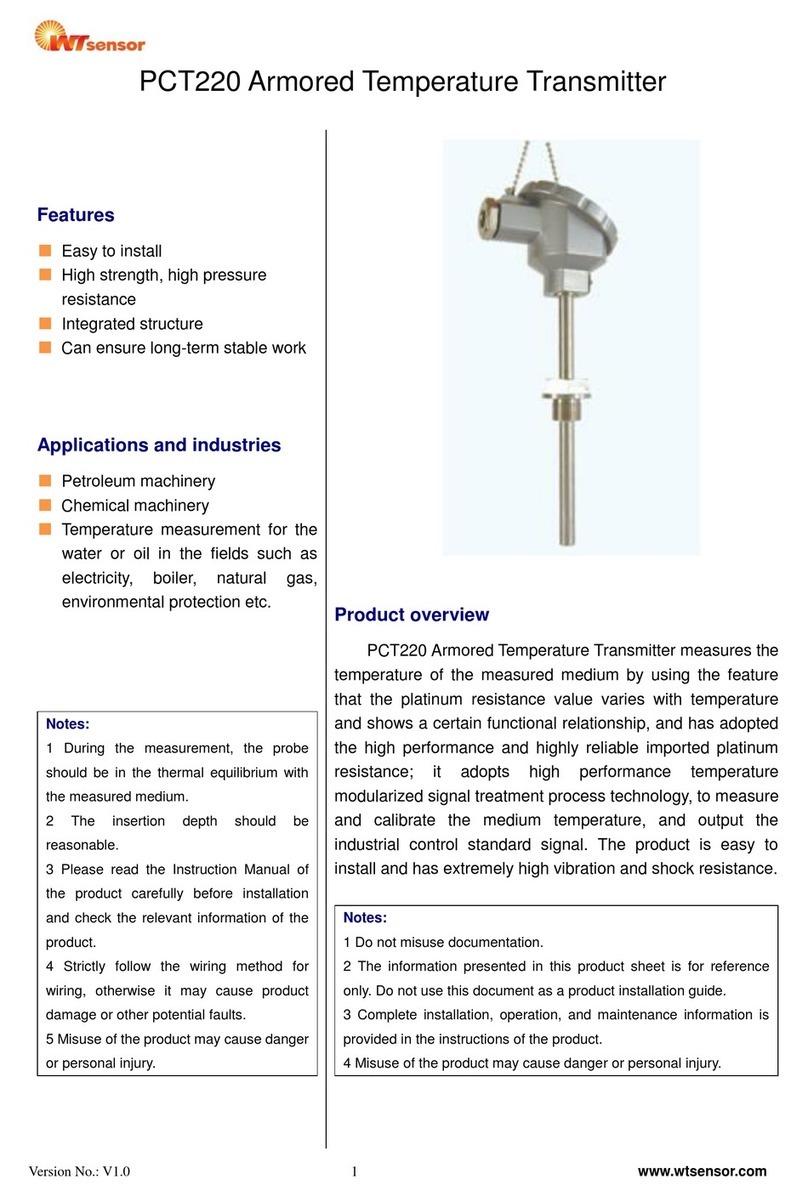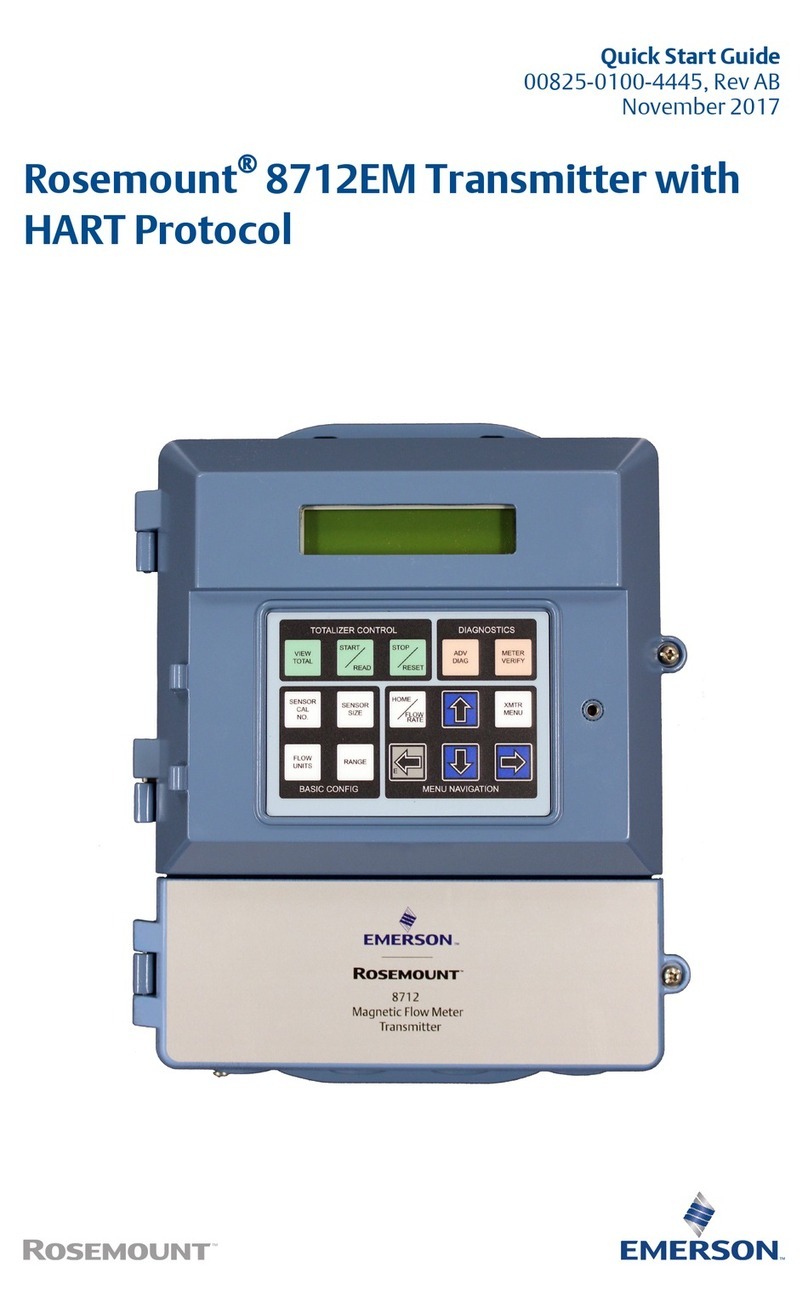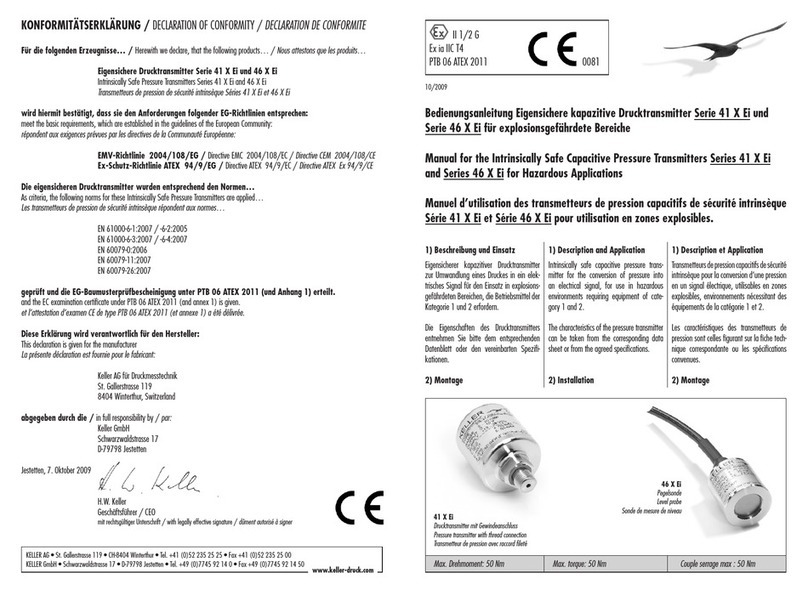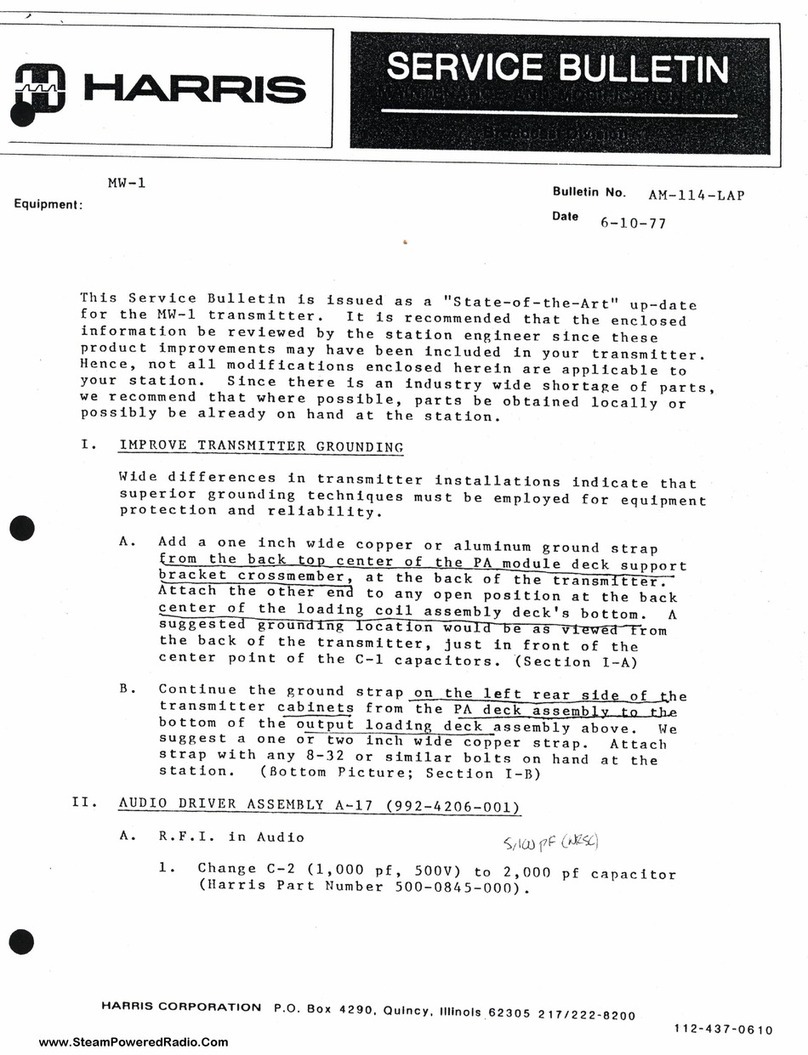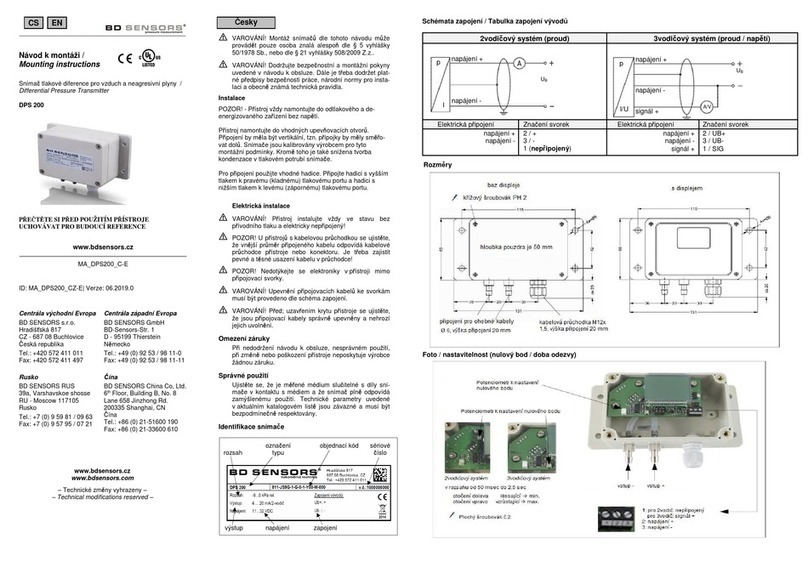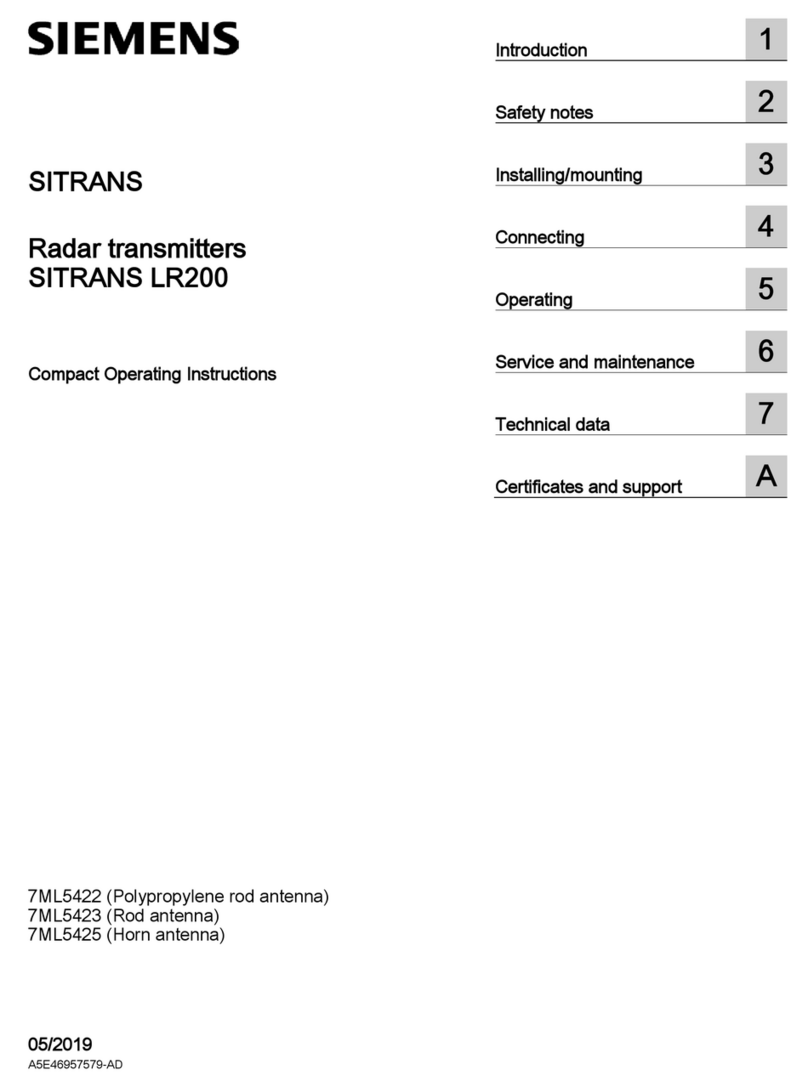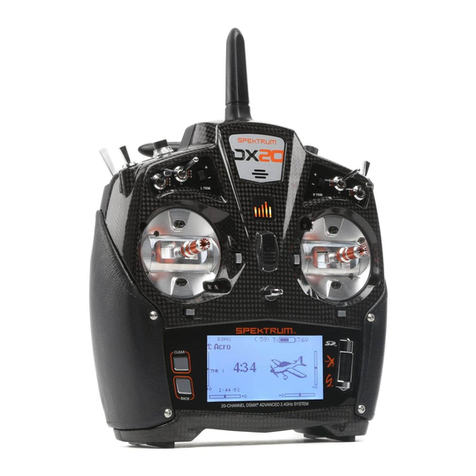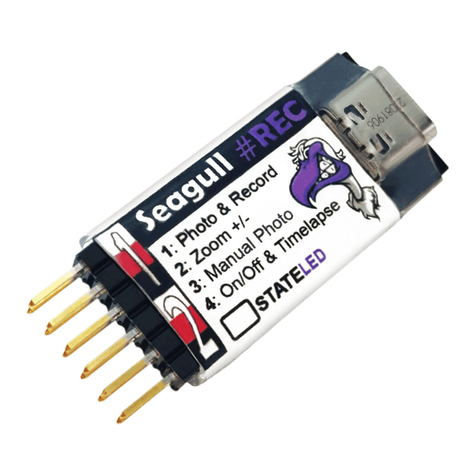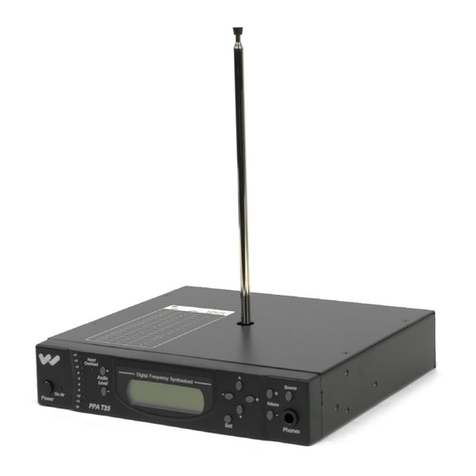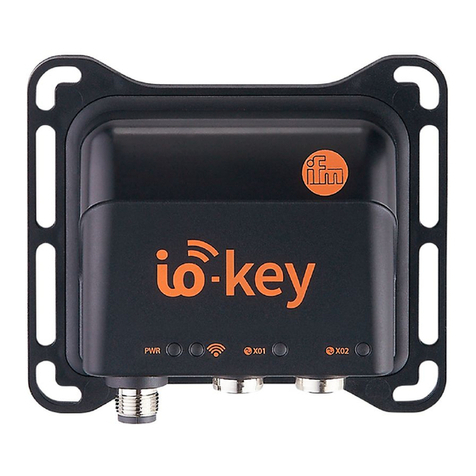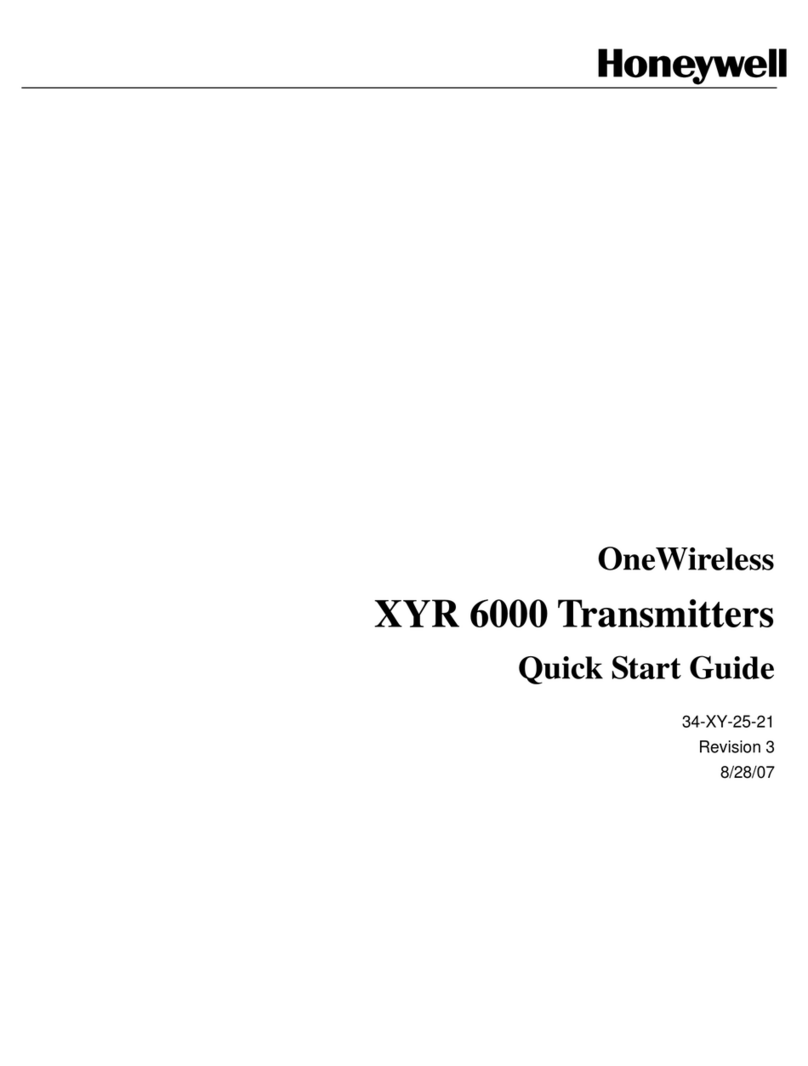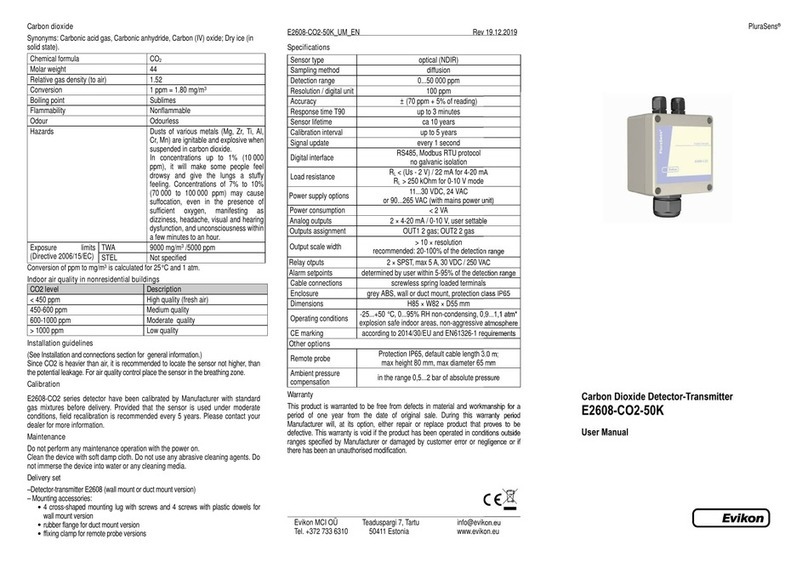Hi-Tec OPTIC 6 Sport User manual

6CH 2.4GHz DIGITAL COMPUTER RADIO SYSTEM
SYSTEM
2.4
Function Assignable
Switches
Easy to Read
LCD Screen
Bulit-in Hitec AFHSS
2.4GHz System
INSTRUCTION MANUAL
0678
6CH 2.4GHz DIGITAL COMPUTER RADIO SYSTEM
2.4
Made in the Philippines

Page 1 Page 2
The Optic 6 Sport 2.4 advanced features include:
Model Memory:
The computer's memory is capable of storing all the necessary trim settings and all the mixes and their nuances for each model (up to a total
of ten models can be registered in Optic 6 Sport 2.4).
The memory is non-volatile-that is, it won't be lost even if the transmitters battery is discharged or even removed.
Pre-mixed Flight Control Functions:
The Optic 6 Sport 2.4 computer automatically mixes rudder and elevator outputs to control a V-tail or mixes aileron and elevator
outputs to create elevons for tail-less flying wings, eliminating the need for on-board mixing systems.
Other pre-mixes include an aileron-to-rudder mix so turns are automatically coordinated and an elevator-to-flap mix for snap-turns.
Sub-Trim Function:
This computerized radio allows you to easily fine-tune and coordinate the control surfaces (such as keeping a rudder centered or two
ailerons-each on their own servo-moving the same amount) without having to physically re-adjust linkages.
Open Mix Capability:
The Optic Sport also features one "open-mix" in which you can choose any two channels to mix the servos master-to-slave, such as mixing
the throttle with the elevator to counteract pitching or the throttle with the rudder to reduce yawing
Buddy-Box Function:
For those learning to fly, the transmitter has a "buddy-box" capability so that you can use the optional trainer cord (part # xxxx) to connect
your Optic 6 Sport 2.4 to a second Hitec transmitter.
This allows one transmitter to be used by an instructor as the primary flight control while the other is controlled by the student pilot.
Releasing a button instantly diverts control from the student's "slave" back to the master transmitter.
If OPTIC 6 SPORT 2.4 is your first programmable radio control transmitter, you're probably feeling a bit overwhelmed by all the buttons and
switches on the case and the cryptic symbols that appear on the radio's LCD screen.
However, if you take little time to read this manual and follow the programming steps as you watch your model's control surfaces respond,
programming the Optic 6 Sport 2.4 will soon become quite routine.
So stick with it. Learning the programming basics won't take any longer or require any more brain power than it takes to do the average
crossword or Sudoku puzzle.
You'll discover that the rewards for mastering this simple but powerful computerized, programmable radio are well worth the effort.
Congratulations! You now own a basic, but unusually versatile and powerful, 6-Channel programmable RC transmitter.
The Optic 6 Sport 2.4 is all the radio you need to fly most types of fixed-wings aircraft-from standard trainers to flying wings to 3-D aerobatic
models to sailplanes (both powered or pure)-as well as most classes of helicopters. As you will learn later in this manual, the ability of this radio to
mix and control many of the channel outputs in a variety of ways allows you to create some surprisingly sophisticated flying functions that were
once available only in much more complex and expensive radios.
Standard programming features include servo-reversing for all channels, subtrim adjustments on all channels, end point adjustment on all
channels and selectable dual rate and exponential values for the ailerons, elevator and rudder.
The primary limitation of this radio is that your models require six or less control channels.
If you are new to Computerized RC Transmitters:
Introducing the Optic 6 Sport
TIP :
Throughout the manual you will see our "Tip Sheet" notes.
These highlight specific function details we didn't want you to miss within the body of the manual.
Check these out, they can make programming the Optic Sport easier.

Page 3 Page 4
Vibration and Water
Mounting
Hitec AFHSS 2.4GHz Technology
Equipment Mounting
When you mount each servo, use the supplied rubber grommets and insert an
eyelet up through the bottom. Be sure not to over tighten the screws.
If any portion of the servo case directly contacts the fuselage or the servo rails,
the rubber grommets will not be able to attenuate vibration, which can lead to
mechanical wear and possible servo failure.
Servo Throw
Factory Repair Service Information
Once you have installed the servos, operate each one over its full travel and
check that the pushrod and output arms do not bind or collide with each other,
even at extreme trim settings.
Check to see that each control linkage does not require undue force to move
(if you hear a servo buzzing when there is no transmitter control motion,
most likely there is too much friction in the control or pushrod).
Even though the servo will tolerate loads like this, they will drain the battery pack
much more rapidly
Please read the warranty card supplied with your system and return it. Before you decide to have your system repaired, if there is no apparent
physical damage, read this instruction manual again and check to be sure that you are operating the system as it was designed to be operated.
If you are still having trouble, pack up your system in its original shipping materials and send it to the nearest authorized Hitec R/C Service Center.
Be sure to include a note in your package that describes the trouble in as much detail as possible, including: " Symptoms of the problem in as
much detail as you can provide, including any unusual mounting conditions or equipment orientation " A list of items you are sending, and what
you want to be repaired. " Your name, address, and telephone number.
Vibration and Water
The receiver contains precision electronic parts. Be sure to avoid vibration, shock, and temperature extremes.
For protection, wrap the receiver in the provided "Flight Preserver" foam rubber, or use some other vibration-absorbing materials.
If your flying near bodies of water, it's also a good idea to protect the receiver by placing it in a plastic bag and securing the open end of the bag
with a rubber band before wrapping it with foam. If you accidentally get moisture inside the receiver, you may experience intermittent operation
or a crash.
Switch Harness Installation
When you are ready to install the receiver's switch harness, remove the switch cover and use it as a template to cut screw holes and a
rectangular hole slightly larger than the full stroke of the switch.
Choose a switch location on the opposite side of the fuselage from the engine exhaust, and choose a location where it can't be inadvertently
turned on or off during handling or storage. Install the switch so that it moves without restriction and "snaps" from ON to OFF and vice versa.
You may run the antenna inside of a non-metallic housing within the fuselage (a plastic outer pushrod housing works well for this), but range may
suffer if the antenna is located near metal pushrods or cables. Be sure to perform a range check before flying. With the 2.4GHz radio system,
the range check method is different from the conventional frequency radio system.
*Detailed range check mothod can be found in page XX. During the range check period, you should be able to walk away at least 75 feet from
the model without losing control or seeing "jitter" in the servos. The range check should be done with the motor running and the model should be
securely restrained in case of loss of control.
Secure the BODA antenna to the 2.4 Antenna Holder (part#xxxxx) and
attach to the inside/outside of fuseslarge or boomtail of an aircraft.
BODA Antenna Installation
Never cut the antenna, such behavior will seriously reduce
the reception range.
Never pinch or bend the antenna, such behavior will cause
serious damage on the antenna.
Changing the length of the antenna reduces range.
Warnings
Pushrod
90
Sponge Pad
Crazy Glue

Page 5 Page 6
Connectors
Be careful if you do choose to use a field charger on your batteries.
A fast-charger may overcharge the batteries, causing overheating and a premature failure. Never charge your transmitter or receiver battery at
a rate higher than the batteries capacity.
For example, the capacity of your Optic 6 Sport's 7.2 volt NIMH battery is 1300 mAh and, therefore, should not be charged at a rate any higher
than 1.3 amps.
Try to charge the batteries with the charger supplied with your system exclusively.
The use of a fast-charger may damage the batteries by overheating and dramatically reduce their lifetime.
Before we dive into the programming and use of the Optic Sport 2.4, let's charge the batteries.
1. Connect the transmitter charging cord to the transmitter's charging socket (on the rear of the case, left side).
2. If your aircraft uses a receiver battery, connect it to the receiver connector on the charging cord.
3. Plug the charger into a wall socket.
4. The charger's LEDs should light, indicating charging is in progress.
If either light does not turn on, verify that the transmitter and receiver power switches are OFF.
The batteries should be left on charge for about 15 hours.
Using Servo Wire Extensions
Be sure the alignment of a servo or battery connector is correct before inserting it into the receiver. To remove a connector from the receiver,
try to pull on the connector's plastic housing rather than pulling on the wires. Pulling the wires can ruin the connector pins and break wires.
If any of your servos are located too far away to plug directly into the receiver (like the aileron servo), or you need to unplug the servo each
time you disassemble the model, use a servo extension cord to extend the length of the servo lead.
Additional Hitec extension cords of varying lengths are available from your hobby dealer.
*Warning: During the OPTIC 6 SPORT 2.4’s charging process, turn off the transmitter power
A training cable may be used to help a beginning pilot learn to fly safer by allowing a second transmitter, operated by an experienced instructor,
to be connected to the Optic 6 Sport 2.4 transmitter. The instructor may override the beginner at any time to bring the model back under safe
control. For training, the transmitter may be connected to another Hitec 2.4GHz system using the Hitec cord part No. #58320 TRAINER CABLE
(between 6 cell transmitter battery systems) or #58321 TRAINER CABLE FULL PACKAGE (#58320 + Slave DIN + Master DIN) - For use
between a 6 cell transmitter battery system and 8 cell transmitter battery system.
4. Between the Transmitter having a DIN jack as INSTRUCTOR and a Transmitter having a STEREO jack as STUDENT.
1) Connect the INSTRUCTOR or DIN Jack adapter marker "Master" with #58320 stereo jack Trainer cable.
2) Power on the INSTRUCTOR transmitter.
3) Plug the combined trainer cable into the INSTRUCTOR transmitter DIN jack connection.
4) The STUDENT transmitter should be turned off.
5) Plug the trainer cable into the STUDENT transmitter with the stereo jack. The power to the STUDENT transmitter will turn on automatically
and you will see "SLV MODE" on the LCD screen which means the transmitter is recognized as STUDENT or "Slave".
6) Though the STUDENT transmitter is powered on automatically, it will not transmit a radio signal as long as the trainer cable is connected properly.
3. Between the Transmitter having a STEREO jack as INSTRUCTOR and Transmitter having DIN jack as STUDENT.
1) Power on the INSTRUCTORS Transmitter having the STEREO Jack.
2) Plug the STEREO Jack trainer cable (#58320) into the Master, or INSTRUCTORS transmitter . Note you will see "MAS MODE" on LCD
screen which means the transmitter is recognized as the INSTRUCTOR or "Master".
3) Connect the DIN Jack adapter marked "STUDENT" from the cable package #58320 to the other end of the stereo connector cable.
This combination enables you to connect the cable to the STUDENT transmitter with a DIN Jack connector.
4) Plug the DIN connector into the socket on the STUDENT transmitter.
5) Finally, power on the STUDENT transmitter. Though it is powered on, the STUDENT transmitter will not transmit the radio signal as long as
the trainer cable is connected properly.
1. To use the trainer system between STEREO Jack Transmitter and STEREO Jack Transmitter (Needs #58320 between 6 cell Battery Radios)
1) Set up both the student's and instructor's transmitter to have identical trim and control motions. If the instructor's transmitter is on a different
frequency than the student's, use the student's transmitter as the master transmitter, and the other transmitter as the student's.
2) Turn on the instructor's transmitter and DO NOT turn on the student's transmitter power.
Plug Trainer Cord (#58320 Stereo Jack) accordingly into each transmitter. The trainer jack is on the back of the transmitter.
Then you can see "MAS MODE" on the LCD screen of Instructor's transmitter and "SLV MODE" on the Student's transmitter screen.
3) Move the controls on the instructor's transmitter, and verify each control moves the proper direction. Now verify that the student's trims and
control travels match the instructor's by using the trainer button (the momentary ENG CUT/TRAINER button on the top right of the
transmitter case) and switching on and off while leaving the control sticks and trims alone, then moving the control sticks.
4) The instructor's transmitter has normal control over the model unless the trainer button is pressed, passing control to the student's transmitter.
If the student loses control, the instructor can quickly "take over" by releasing the trainer button and then controlling the model.
2. To use the trainer system between a STEREO Jack Transmitter and a DIN Jack Transmitter.
(Needs trainer cable package #58321 between 6 cell Battery Radio and 8 cell Battery Radio system) ease read the following instruction
carefully for using transmitters with DIN Jack and/or stereo jack for the trainer system. You will need the Trainer cable full package (#58321).
This full package is consists of a STEREO Jack trainer cable(#58320), Instructor DIN Jack and Student DIN Jack Adapter.
This package allows the proper connection between a 6 cell battery system radio (ex. Optic 6 Sport 2.4, Aurora 9) and 8 cell battery system
radios (ex. Optic 6 2.4 / Eclipse 7 2.4).
Operating with a Trainer Cord
2.4GHz 6 CHANNEL RADIO CONTROL SYSTEM
2.4
ᯙჩ⪙)3,015*$41(
'$$*%*')015*$41(
*$"015*$41(
ݚ⧕ྕᖁᖅእ۵ᬕᬊᵲ
ᱥ❭⪝ᝁa܆ᖒᯕᯩᮭ
Ma
de in the Philippines
www.hitecrcd.com
Charge the Batteries!
NOTE: If you need to remove or replace the transmitter battery, do not pull on its wires to remove it.
Instead, gently pull on the connector's plastic housing where it plugs in to the transmitter.
The battery must be removed to charge it properly with a "peak" charger.
NOTE:
1. WHEN USING THE TRAINER SYSTEM IN THE STEREO JACK TO STEREO JACK FORMAT AS NOTED IN
THE NEXT SEVERAL PARAGRAPHS, BOTH TRANSMITTERS ARE GOING TO TRANSMIT.
2. IF THE SLAVE TRANSMITTER HAS A REMOVABLE MODULE, REMOVE IT.
THEN, IT WILL NOT BE TRANSMITTING. OTHERWISE, IF YOU ARE FLYING AT A CLUB FIELD USING
FREQUENCY CONTROL, BE SURE YOU HAVE THE OK TO USE BOTH FREQUENCIES.
3. IF THERE IS NO REMOVABLE MODULE ON THE SLAVE TRANSMITTER, BOTH TRANSMITTERS MUST BE ON
DIFFERENT FREQUENCIES.
NOTE
This section tells you how to connect the transmitters only.
Please read the prior sections for the full information needed to properly operate the trainer cable system.
NOTE : There is no sign of recognition on the LCD screen of the Transmitter using the DIN jack.
NOTE
1) Do NOT turn on the power of the STUDENT transmitter having the STEREO Jack. Once you plug the trainer
cable into the STUDENT Transmitter using the STEREO Jack, it will be powered on automatically.
2) All Transmitters in the trainer system use their own batteries. Both batteries in both the Instructor and Student
Transmitters should be properly charged and installed when flying in the trainer mode.
3) You may wish to use a simple "contractors cord" knot on the cable to adaptor connection to keep it from
coming "unplugged" when using it. Heat shrink tubing or electrical tape can also be used.
Caution: Stop flying and bring back your aircraft and land at once, when your transmitter start beeps
for low battery warning. (L.B.W. activates when battery level hits below 6.6V)

Page 7 Page 8
Stick Lever Tension Adjustment
Change to ‘Mode 1’ Configuration
- Before you fly, perform a range check to confirm your radio system is responding correctly.
- To do a range check, Power-up the aircraft and either ask a friend to help hold the aircraft or secure it somehow.
- Walk away from the aircraft until the aircraft "glitches" or you notice intermittent control loss .
- Walk back to the aircraft, pacing out the distance.
- When you are ready to fly your model, position the throttle stick or switch to its low speed or off position.
Then, you may turn on the transmitter power followed by the receiver power.
- Use the LOCK function to prevent accidental throttle commands.
- When you have finished flying, turn off the receiver power first- then turn off the transmitter power.
- In case of electric-powered models the motor may unexpectedly turn on and cause a severe injury if the transmitter is switched off before
the receiver.
- Before starting the engine, power up the transmitter and receiver, and check to be sure that the servos follow the movement of the sticks.
- If a servo operates abnormally, don't attempt to fly until you determine the cause of the problem.
- Before starting the engine, be sure to check that the transmitter model memory is correct for the chosen model.
- While you're getting ready to fly, if you place your transmitter on the ground, be sure that the wind won't tip it over.
- If it is knocked over, the throttle stick may accidentally get moved causing the engine to race unexpectedly, causing damage or injury to
anyone nearby.
- Finally, don't fly in the rain! Water or moisture may enter the transmitter through the antenna or stick openings and cause erratic operation or
loss of control.
To ensure your own safety and the safety of others, please observe the following precautions:
We recommend that you fly at a recognized model airplane flying field.
You can find model clubs and fields by asking the nearest hobby dealer, or contacting the Academy of Model Aeronautics.
Always pay particular attention to the flying field's rules, as well as the presence and location of spectators, the wind direction, and any
obstacles on the field.
Be very careful flying in areas near power lines, tall buildings, or communication facilities as there may be radio interference in their vicinity.
Flying Safety
Stick Length Adjustment
You may adjust the stick tension of your sticks to provide the "feel" that you like for flying. To adjust your springs, you'll have to remove the
rear case of the transmitter. Using a screwdriver, remove the six screws that hold the transmitter's rear cover into position, and put them in a
safe place. Now, place some padding under the front of the transmitter and set it face-down on the pad.
Gently ease off the transmitter's rear cover. Now you'll see the view shown. Using a small cross-point screwdriver, rotate the adjusting screw
for each stick for the desired spring tension.
The tension increases when the adjusting screw is turned clockwise, and decreases for counterclockwise motion.
When you are satisfied with the spring tensions, you may close the transmitter. Very carefully reinstall the rear cover.
When the cover is properly in place, tighten the six screws.
Stick Lever Tension Adjustment / Mode Change
All Optic 6 Sport 2.4 systems sold in US are in ‘Mode 2’ format. However, you may wish to use Optic 6 Sport in ‘mode 1’ format.
There is a menu choice for this option in the Initial Set-Up function menu described on Page 15.
After selecting ‘Mode 1’ in the Initial Set-Up Menu, you must do the following hardware set-up in order to change the transmitter
1. Carefully remove the plastic side panels from the transmitter.
2. Remove all the six philips screws from the back of the case
3. Unscrew a hex screw to remove the Copper Ratchet from where it llocated and move it to the other side
4. Tighten up the tension spring hex screw on the new location
5. Loosen up the tension spring hex screw on the original location.
6. Re-assemble the case.
Hands come in all sizes so to accommodate everyone we use a two piece stick “top” that can be adjusted to fit a wide variety of users.
Separate the top from the bottom piece and adjust the top piece to the length required.
Screw the bottom up against the top piece to “jam” lock everything into position.
Flying field
Once you arrive at the flying field...
Note: Please use XXmm or XXinch Hex key for tension adjustment and mode changes.
Note : We want a good range check to be at least 75 feet or so.
If you do not follow these procedures, the receiver has no information to hold the servos steady and
you may damage your servos or control surfaces or flood your motor.
If you must fly in wet weather during a contest, be sure to protect your transmitter with a plastic
bag or waterproof barrier.

Page 10 Page 11
This pair of buttons has three basic functions: they get you into the initial setup menu when you hold both EDIT buttons down and then turn on
the radio; they get you into the model setup menu when you push both down when the radio is already on; and once you are in either of these
menus pushing one button scrolls you up or down through the list of menu items.
"EDIT" buttons
When you are in a particular menu item, you'll use these two buttons to scroll within it-most commonly to the right or left to select a servo
channel. When not in the programming mode, these buttons start, stop and reset the radio's countdown timer.
"CURSOR" buttons
As the "+" and "-" symbols imply, these buttons allow you to change a numerical value (most often a % value of servo travel) up or down within
a menu item. When not in the programming mode either of these buttons enable the countdown timer.
"DATA" buttons
This button is primarily a safety feature for powered models: When you push this button down the throttle channel on the model is taken
off-line so that an accidental movement of the throttle stick won't change the setting. Get in the habit of using this function whenever you are
carrying your model to the flight line.
"LOCK" button
KEEP YOUR HANDS AWAY FROM THE PROPELLER OR ROTORS EVEN AFTER ENABLING THE LOCK
FUNCTION-A RADIO GLITCH COULD STILL ACTIVATE THE THROTTLE !
SAFETY NOTE
You can use the clear button whenever you want to reset a numerical value to its starting point. It is also used in one of the menu screens
(the P MIX TRM) to turn a function on or off.
"CLEAR" button
Optic 6 Sport Controls and Switch Assignments
This figure shows the assignments for a Mode 2 system as supplied by the factory.
Note that some of the functions will not operate until activated in the mixing menus.
Trainer/Engine Cut Switch
SW 3
SW 1
Rudder &
Throttle Stick
Aileron &
Elevator Stick
Plastic Side Panel
SW 2
Antenna
Trim Switch
Optic 6 Sport Programming Switches and Buttons
This switch does more than just turn the radio on and off-it also gets you into the initial setup programs when you hold down the two "EDIT"
buttons as you slide the switch from "off" to "on".
When you turn off the switch after making selections in the initial setup menu, you "lock" your choices into the radio for this particular model slot.
The switch is coupled to the light located a couple of inches above it-it comes on when the switch comes on and goes off when the switch is turned
On-Off Switch
Power Switch

Page 11 Page 12
Right-hand joystick
Left-hand joystick
"SW-1" switch
"SW-2" switch
Optic 6 Sport 2.4GHz Transmitter Features
Depending on the initial set-up base-line programming you have selected, this switch can be used to lower landing gear;
operate the throttle of an electric motor (as on a powered glider); or select a flight condition mode. In Heli mode, this is the throttle hold switch.
This is your "Dual-rate" switch: The "0" position typically selects the full rate of movement of the aileron, elevator and rudder while the
"1" position selects the diminished rate you have programmed in the model setup menu. The exponential values for these control surfaces
are also selected by this switch.
"SW-3 FLT MODE" switch
This switch allows you to choose three different "flight condition modes"-an advanced programming function.
In Heli mode this switch selects the NOR, or "hover", and 2 "idle-up" or stunt modes
"Eng Cut"/"Trainer" switch
If you've activated the engine cut function in the model setup menu programming, this button serves as the kill-switch for your motor.
Otherwise, it functions as the trainer switch when your transmitter is linked via a cable to a second transmitter to act as a "buddy box"
for flight training. As long as you hold down the training button the buddy box will be flying the model-let go of the button and your transmitter
reverts to being the master.
Trim switches
Use these switches to make small offset adjustments to the servos controlled by the two joysticks.
Any adjustments will be "memorized" for this particular model so you won't have to re-trim every time you fly.
1. Function Button (With Dual LED Status Indicator)
This Function Button with Dual LED indicator has two colored LEDs, blue and red, for status indication and for set-up process indication of
2.4GHz system.
This function button can be used for Link(ID -Setting) process between Optic 6 Sport 2.4 to a Optima series receivers, entering the
power down mode for range checks, and the Nomal / Scan Mode set-up.
2. Sensor Data Output and System Upgrade Connector Port
A three pin servo plug connector port is featured on the 2.4GHz module.
Using the HPP-22 PC interface accessory this port serves to facilitate upgrading the devices software and downloading information from
Optima 7 and 9 channel receiver if using optional onboard sensor station.
Joystick Controls
Assuming you have selected "Mode 2" in the initial setup menu (the most common control arrangement in North America), this stick controls
the elevator (forward is down and back toward you is up) and the ailerons (left and right).
Again assuming the "Mode 2" configuration, this stick controls the rudder (left and right) and the throttle (forward and back-back is off for
electric motors and idle for glow). If you have selected "GLID" as the transmitter's programming baseline in the initial setup menu than the
stick's forward and back movement controls the ailerons and flaps for the model's descent control (called "CROW").
LEFT RIGHT
RIGHT
LEFT
Front View
LEFT
RIGHT
DOWN
UP
DOWN
UP UP
DOWN
HIGH
LOW
HIGH
LOW
HIGH Position:
Full Throttle
LOW Position:
Power Off
LEFT RIGHT
RIGHT
LEFT
Front View
RIGHT
LEFT
The following contains the complete instructions on how to use the Hitec AFHSS 2.4GHz system on Optic 6 Sport 2.4 and Optima series receiver set.
We encourage you to review this information before using these products.
*$41
015*$
1(
ݚ⧕ྕᖁᖅእ۵
2.4GHz 6 CHANNEL RADIO CONTROL SYSTEM
2.4
ᯙჩ⪙)3,015*$41
015*$41(
1(
ݚ⧕ྕᖁᖅእ۵
1
2
Note : Only the basic telemetry function (Receiver Low Battery Warning) is available for Optima 6.

Page 13 Page 14
1. Function Button
Used for Linking(ID-Setting) the receiver to a module,
entering Fail-Safe / Hold mode setup function.
2. Dual LED Status Indicator
Indicates the set-up process codes and use status.
3. SPC Supplementary Power Connection
Power the Optima receiver function with up to a 35V. motor battery.
Details about the SPC system can be found on page 21.
4. Channel Output and Battery Input Ports
The ports for battery power, servos, gyros and other accessories are located at each end of the streamlined Optima receivers.
5. Jumpers
The jumper is installed at the factory and is used when the receiver is powered by an electronic speed control, a commercially available
B.E.C. (battery eliminator circuit), dedicated 4.8 to 6V. NiMH battery pack, or *2S Li-Po/Li-Fe batteries.
The jumper is removed when the receiver is powered using the SPC feature as described in more detail on page 19.
6. BODA (Boosted Omni Directional Antenna) System
- Hitec’s exclusive 2.4GHz BODA Antenna System will show you another meaning of using 2.4GHz system, this
single antenna with Omni-directional booster makes whole lot easy to install the 2.4GHz antenna. Intensive
test have proven that the single BODA antenna system in our 6 & 7 channel systems is better than or equal
to our competitors dual antenna systems while our Optima 9 receiver features a dual BODA system to give
the added security that larger models need. Installation is easy and simple, insert the antenna into the
supported Antenna holder and stick it to the desired spot you wish to install.
Optima 6 Receiver Features Optima Receiver Connection Diagrams
Follow this connection diagram when using a dedicated 4.8 to 6.0V NiMH battery pack, or *2S Li-Po/Fe 7.4V batteries.
Use this method on electric planes using ESC’s providing power, A.K.A. BEC (Battery Eliminator Circuit), to the receiver and servo functions.
As of this writing, there are three Optima 2.4GHz receivers that are compatible with the Hitec AFHSS 2.4GHz System.
The Optima 6, Optima 7 and the Optima 9 are loaded with a variety of functions that are sure to deliver a satisfying R/C experience.
Normal / Scan Mode Selectable
Select between two operational signal types. See page 17 for details.
FAIL-SAFE Option
Servos and other accessories may be programmed with a FAIL-SAFE point in the event power to the receiver is interrupted.
See page 18 for details.
Onboard Receiver Battery Warnings
Know when your on-board battery is low with direct telemetry feedback to your transmitter. See page 19 for details.
Warning :*Verify your servos are rated for use with these higher voltage batteries or use a regulator.
Warning : Verify your servos are rated for use with higher voltage(7.4V) batteries or a regulator.
Functions:
Glow, gas, nitro or electric powered aircraft using a separate receiver battery.
Electric powered aircraft with Electronic Speed Control
5
Optional BEC shown in diagram. It is recommended to use large capacity BEC where number of
high torque servos are used and power requirements exceed which the ESC provides.

Page 15 Page 16
ID-Setup A.K.A, Link or Bind
Optima Series Receiver Features and setup
Set-up and Use of the Hitec 2.4GHz System
Normal Mode / Scan Mode Configuration
To turn the system on and off, use the following sequence at all times
Turning Off -Turn off the receiver, then turn off the transmitter.
Turning On -Turn on the transmitter, then turn on the receiver.
Optima Series Receiver Features
< Normal Mode >
< Scan Mode >
Press and hold the button on the back of the transmitter, and turn on
the transmitter.
Release the button.
Red LED will blinks to indicate
searching for a receiver.
Press and hold the button on Optima 6,
and turn on the power.
Release the button.
After receiver linked to the transmitter, the red LED glows
solid and the blue LED flash’s on the module.
To save the setting turn the power off for both receiver and
transmitter. Don’t forget to turn off sequence.
Scan Mode and Normal Mode Selection
Hitec’s Spectra 2.4GHz module and Optima series receivers have two different operational modes to choose from,
“Normal Mode” or “Scan Mode.”
There are available 2.4GHz channels that can be used by your Hitec AFHSS 2.4 system.
The following will explain how Normal Mode and Scan Mode use the channels.
Normal Mode
- In this mode the receiver/transmitter uses initial factory default frequency set up.
- Every start up both transmitter and receiver will hop within the preset 2.4GHz frequency band.
- After the initial set-up, the everyday start-up is quicker in the Normal Mode, and in most cases the Normal Mode
is preferred by users.
- In the Normal mode, if the transmitter or receiver loses power, then power is restored, the system will reconnected
and function normally.
- The factory default setup is Normal Mode.
Scan Mode
- In Scan Mode the receiver/transmitter will scan all available channels every time you turn it on.
It will then choose the cleanest frequencies to use. Scan Mode is preferable to use when flying in a crowded
2.4GHz environment.
- While in Scan Mode if the transmitter loses power, the Fail-Safe function will activated, that’s only when the
Fail-Safe Position is previously setup. To reconnect the system you need to bring back the aircraft to the ground
and reboot the system.
- In all cases the Scan Mode binding function will take longer than in Normal Mode when you boot-up the system

Page 17 Page 18
Optima Series Receiver Features and setup
Set-up and Use of the Hitec 2.4GHz System
1Sec.
3Sec.
3Sec.
Turn on transmitter, then the receiver.
After connected, make sure you have control over the model.
Then press & hold the button on the back of transmitter for 6 seconds,
you will hear one beep followed by two beeps then release the button.
Approximately one second after button released, the system will switch to Scan Mode
noted by the blue and red LED and one beep.
Switching from Normal Mode to Scan Mode
1Sec.
3Sec.
3Sec.
Turn on transmitter, then the receiver. You will hear two short beep sound for Scan Mode
You will hear four short beep
sound for Normal Mode
After connected, make sure you have control over the model.
Then press & hold the button on the back of transmitter for 6 seconds,
you will hear one beep followed by two beeps then release the button.
Approximately one second after button released, the system will switch to Normal Mode
noted by the red LED and two beeps.
Switching from Scan Mode to Normal Mode

Page 19 Page 20
Optima Series Receiver Features and setup
Optima Series Receiver Features and setup
Set-up and Use of the Hitec 2.4GHz System
Always do a pre-flight function check
Before the engine or motor is started, turn on the system as explained above. Then make sure all the servos and control surfaces are
working properly. If any control surface is not moving properly, do not fly the aircraft until the problem is solved.
Range Check
Do a complete range check as described on page 18 before each flying session to confirm the radio system is working properly.
Your Hitec AFHSS system uses a communication protocol that links and binds the Optima receiver to your Aurora transmitter. Once their
ID is set, no other transmitter can interfere with your receiver during its operation. In the case of multiple model memory transmitters like
Aurora 9, you can bind or link as many Optima receivers to your transmitter as necessary.
- Binding must be done within 15ft. (5m) of the transmitter and receiver.
- Transmitter and receiver need to be at least 18in. (45cm) from each other to binding properly.
- In the ScanMode, if the transmitter or receiver has been shut off or disconnected for more than one second,
note : Each system and module / receiver set is paired at the factory for your convenience.
Use the following Link (ID-Setting)
sequence as you add Optima receivers into other aircraft to be controlled by your Aurora.
Note : both module and receiver need to re-boot (turn the power off, and back on).
FAIL-SAFE and Hold Mode
FAIL-SAFE Setup
If you use the FAIL-SAFE function, and set it up properly, should the receiver signal somehow be interrupted or interference were to occur,
the servos will move to your pre-set FAIL-SAFE point you previously stored in the receiver during the FAIL-SAFE set-up process.
If FAIL-SAFE has not been activated, the signal is switched off after the HOLD period of 1 sec. This means that the servos become “soft” and
remain in their last commanded position under no load (this may equate to full-throttle!), until a valid signal is picked up again.
In the interests of safety, we recommend that FAIL-SAFE should always be activated, and the FAIL-SAFE settings should be selected so as
to bring the model to a non-critical situation (e.g. motor idle / electric motor OFF, control surfaces neutral, airbrakes extended, aero-tow
release open, etc).
6Sec.
5Sec.
Fail-Safe position
Switch on both.
Wait for the system to boot and control over the model.
Press and hold the button on the Optima until LED turns off
(approx. 6 second)
Release the button. After 2 seconds both red and blue LEDs blink rapidly.
the receiver will count 5 seconds during that time move all the transmitter
sticks and other controls to the desired FAIL-SAFE positions
(e.g. motor idle, control surfaces neutral), and hold until blink stops.
When Blink stops the system will temporary remember the FAIL-SAFE position, turn off the system to save.

Page 21 Page 22
Telemetry System
SPC (Supplementary Power Connection) System
Optima Series Receiver Features Optima Series Receiver Features and setup
It is critical that before each flight session you perform a range check that confirms the signal between the receiver and transmitter is
appropriate.
Unlike the FM/PPM or PCM signal radios, 2.4GHz systems use a fixed shorter, stubby transmitter antenna so the traditional method of range
checking your system by lowering the transmitter antenna will not work.
We instead use a power-down mode to reduce the transmitter signal strength. Once the power-down mode is activated it runs for about
90 seconds, shortening the effective range 100 feet (30 m).
During this power-down mode that you should walk away from the secured aircraft carrying the transmitter to a distance of approx. 30 meters,
testing the effective range.
Currently there is a direct feedback telemetry function available in your Hitec 2.4 system.
Plans are to have many more devices available in the future.
Check the Hitec website at www.hitecrcd.com for more up-to-dated information.
The Hitec Spectra 2.4 Module and Optima Series receivers feature full telemetry capabilities (except Optima 6) and include a Low Receiver
Battery Warning as a basic function.
The low battery voltage warning level can be customized with the HPP-22 & PC program.
When 2.4GHz system and HV servos are used together, we strongly recommend using large capacity battery pack with fully charged
condition, and constantly monitor the battery status. Also when ESC, with BEC, is used it is strongly recommended to obtain enough
capacity (Approximately more than 3A).
Hitec’s exclusive optional receiver power system allows you to directly power the receiver from the main motor power battery of an electric
powered aircraft. Up to 35 Volts can be fed directly into the receiver to power JUST THE RECEIVER FUNCTION. (It will not power the servos)
Almost all servos will burn-up if more than 6 Volts are used over a short period of time. Some Hitec servos are rated to be used at 7.4Volts.
You will still need to supply power for your servos with a four or five cell NiMH receiver battery, 2 cell Li-Po, a regulator set-up, or a
commercially available BEC with enough capacity (3A or more capacity is recommended).
The SPC system was partially created to be integrated into future Hitec telemetry system devices.
SPC Receiver Connection Diagram
Range Check Function
How to use Power-Down
Low Battery Warning
The 2.4GHz system will automatically recognize the receiver battery voltage among 4 and 5 cell
NiMH or NiCd batteries and warns you, and also 2S LiPo/LiFe battery packs can be used with battery
warning level customization. (HPP-22 required)
- When battery level is high(4cell > 4.5V, 5cell > 5.6V): The red module LED glows constantly.
- When battery level is low(4cell < 4.5V, 5cell < 5.6V): Blue LED glows constantly and the red LED will blink fast.
You will hear a continuous loud beep from the module as a low receiver battery warning.
Upon hearing the alarm, we advise you to bring back the aircraft and land at once.
Testing the FAIL-SAFE Setting
- If FAIL-SAFE is deactivated, the FAIL-SAFE position settings are also deleted!
- The FAIL-SAFE settings should be checked every time before you run the engine/motor.
a. Move the sticks to positions other than the FAIL-SAFE settings, and then switch off the transmitter.
The servos should now move to the FAIL-SAFE positions previously stored, after the HOLD period (1 sec.) has elapsed.
How to turn FAIL-SAFE Off and reactivate the Hold Mode
a. Switch on the transmitter, then the receiver. Wait for the system to boot and you have control over the model.
b. Press and hold the receiver function button for 6 seconds and release it. After 2 seconds the red and blue LEDs will blink rapidly.
c. Push the function button once shortly, during the time LED blinks. (approx. 5 seconds)
d. FAIL-SAFE Mode is now deactivated, and HOLD mode is activated instead.
e. Turn off the transmitter and the receiver to save the setting.
f. Turn the system back on to use it.
3Sec.
90Sec.
Press the function button on the back of transmitter and
hold for 3 seconds.
Release the button to enter the mode. Power Down Mode is actvated for 90 second countdown starts
from the time the button released.
After 3 second Optic 6 Sport will beep once to notify you that
the system is in Power Down Mode.
If you are unable to accomplish a successful range check of 90 feet, DO NOT ATTEMPT TO FLY.
Note : Check the Hitec web site for more information on the availability of telemetry systems in the future.

Page 23 Page 24
Startup Screen
FAIL-SAFE and Hold Mode
Receiver-Servo Connection List
Transmitter Displays and Messages
The table below shows where the aircraft's servos should plug into a six-channel receiver. Note that some functions shown will not operate
until they are activated in the transmitter. The standard function is listed first for each channel.
When you first turn on your transmitter, the first screen shown below appears on the LCD display. Before flying, or even starting the engine,
BE SURE that the model number appearing next to the voltage matches the model that you are about to fly! If you don't, reversed servos and
incorrect trims will lead to an immediate crash.
If you press timer or engine cut or lock keys, you go directly to those functions regardless of the display.
This screen appears whenever you turn on the transmitter without pushing any other buttons.
The model number currently enabled is the small number just to the right of the battery voltage and
the programming baseline for this model (ACRO, GLID or HELI) is shown in the upper left hand corner.
In the center bottom of the screen "NOR" appears in a small black box indicating that the transmitter
is in the "Normal" flight mode condition.
Lock Indicator Screen
When you push the Lock button to hold the throttle at an idle, the word "LOCK" appears in a black box
above the voltage value.
When you push the lock button again, this symbol disappears to indicate that you have disabled
the function.
Timer
If you push either DATA button, you will enable the radio's timer mode.
The word "TIMER" appears on the screen as well as a number indicating the starting countdown
time (which you can set in the Initial Setup menu). If you push the right hand CURSOR button,
the timer will start counting down and the numbers will diminish in one-second increments.
Push it again and the countdown stops.
Pushing the left hand CURSOR button resets the timer.
Warning Display (Low voltage)
When the battery's voltage drops to 6.6 volts, this number starts blinking on the screen and the
transmitter begins to steadily beep.
If your plane is up in the air when this happens, land immediately so you can recharge the battery.
Warning Display (Flight Condition other than NOR)
If you turn the transmitter on and it immediately starts to beep while displaying the word "ON" on
the screen, one of the flight condition modes other than Normal is switched on.
The symbol in the black box at the bottom of the screen indicates which switch (SW1 or SW3)
needs to be reset to Normal.
Rx. Ch. ACRO GLID HELI
Aileron Aileron Roll Cyclic
One or Right Flaperon (FLPN ON) or Right Aileron (ADIF on) or Swash servo 1 (120¡Æ)
or Right Elevon
Elevator Elevator Pitch Cyclic
Two or Right V tail (VTAL on) or Right V tail (VTAL on) or Swash servo 2 (120¡Æ)
or Left Elevon (ELVN on)
Three Throttle (BEC In / Motor Signal Out)
Four Rudder Rudder Tail Rotor
or Left V tail (VTAL on) or Left V tail (VTAL on)
Five Landing Gear Left Aileron (ADIF on) Gyro Gain
Six Flap Flap Collective
or Left Aileron (FLPN on) or Swash Servo 3 (120¡Æ)
Transmitter Displays and Messages
Initial Setup Menu Programming for All Aircraft
Map of Basic Menu Functions
MODEL Model select: choose on of ten model memories 14
ACRO Acrobatic model mode 14
GLID Glider model mode 14
HELI Helicopter model mode 14
SWAH 90 Nomal Swash Plate (HELI only) 14
SWAH 120 120* Swash Plate (HELI only) 14
TMER Timer setup 15
MODE 1 Transmitter mode 1 15
MODE 2 Transmitter mode 2 15
SFT N Negative Transmit Shift 15
SFT P Positive Transmit Shift 15
RST Reset memory 15
Model Select 0~9 [MODEL]
Model Type
[ACRO] or [GLID] or [HELI]
Swash Plate type (HELI only)
[90] [120]
Timer setup [TIMER XX]
Mode 1 and Mode 2
Shift Dir. [SFT N] [SFT P]
Reset Memory [RST]
If this is your first Airplane
If this is your first model Airplane, here are a few tips that will streamline your experience in
programming it.
This will make more sense after you read through the manual.
Refer back to this section when you are ready to begin the setup:
1. Start with the correct model type, ACRO, in the Initial Setup Menu.
2. Access the main programming menu, then use the REV function, and make sure all the servos are moving
in the proper direction.
3. After centering the servo arms manually as close as you can, use the S.TRM or sub-trim function to center
the servos.
4. Set your servo end points with the EPA function.
5. Program -35% EXPO values for aileron, Ch. 1 and elevator, Ch. 2.
6. After your Plane is all ready to fly, put it on a shelf and go get an R/C flight simulator program for your PC.
Spend quality time crashing the virtual plane in the simulator. Using a sim will save you hundreds of dollars
spent on spare parts and countless hours of rebuilding time in the long run.
7. Ready to fly your new Plane? If you are lucky you will know someone that is an experienced model pilot and
would be willing to check over your plane and take it up for its first flight. This is HIGHLY RECOMMENDED,
even if you have to drive a hundred miles to get to this person!
If you are on your own, start slow and conservatively.

Page 25 Page 26
1. Select a model slot:
4. Configure the countdown timer:
2. Select the Model type programming baseline:
3. Heli Swash Plate:
Before you turn on the transmitter to begin programming one of the model slots for your aircraft, refer to the servo connection chart on page 12,
to see how to plug the servos into their proper channel sockets in the receiver.
Don't turn on the receiver in your model just yet - we'll tell you when to do so.
First we'll get started setting up the aircraft in the Initial Setup program menu, then we'll continue into
the Main Function menu to configure the servo responses and travels of your particular model.
Hold down both EDIT buttons and slide the on-off switch to "on".
The transmitter will beep, the red light will come on, and on the LCD screen you will find yourself in the
first menu item of the initial setup menu.
Under the word "MODEL" the number will be blinking on and off to get your attention.
If this is the first model you are setting up in this transmitter, go ahead and accept this numbered slot by
pushing the right-hand EDIT button to scroll down to the next menu item.
When there are already models inputted, the number that comes up when you turn on the transmitter
will be the last activated model slot.
To change to a different slot, push on one of the CURSOR buttons to go to an empty slot
(consult your list!) and then scroll to the next screen to automatically select it.
In the second menu screen, the programming baseline of ACRO, GLID, or HELI will be blinking.
Since we are setting up a powered aircraft, select ACRO by scrolling to it with a CURSOR button.
Push down both DATA buttons simultaneously to tell the program to accept the choice-you should
hear the transmitter beep twice in acknowledgement.
Now push the right-hand EDIT button to move to the next menu screen.
If you selected HELI as your model type, this screen will appear allowing you to select between
NORMAL (90 degree mechanical) or 120 degree swash plate heli's by pressing one of the
CURSOR buttons.
Find out which one of these popular swash formats your helicopter uses and select it here.
After selecting the appropriate swash type, continue down to the next menu item.
Initial Setup Menu Programming for All Aircraft Initial Setup Menu Programming for All Aircraft
Now you are at the TIMER menu item with a number blinking away at you-its 10 (minutes) by default.
If you want to set a timer value, go to page 12 for more information on using the timer function.
Otherwise, move down to the next menu item.
5. Select the control's Mode configuration:
6. Select the signal shift:
Under the word "MODE", the number "2" is blinking by default.
Go ahead and accept mode 2 by pushing the right-hand EDIT button to continue to the next screen.
Of course, if you are used to the mode 1 configuration (elevator on the left stick, throttle on the right),
then select number 1. Other changes to accommodate Mode 1 flyers must be done to the transmitter.
Please refer to page 7 for more information.
As indicated by the "SFt" symbol on the screen we are now in the shift selection menu.
The blinking default selection is "n", meaning negative shift.
If your receiver is marked "positive" shift, push one of the CURSOR buttons so that a "P" starts blinking.
Then scroll to the next screen.
7. Reset Screen:
In this screen you should now see a tiny "RST" blinking in the lower right hand corner This means
RESET-and if you push both DATA buttons at the same time that's exactly what will happen: You will
hear a "double beep" and undo all the initial programming we just did, returning all the programming to
the factory's default settings!
Now push the Right EDIT button to scroll right back where we started when we first turned on the transmitter.
We are now done with the initial setup programming of your aircraft, so switch off the transmitter.
When you switch it on again without holding down both EDIT buttons the transmitter will open up in the current model slot (the one we just
programmed) with all the initial settings we just programmed in effect.
The Optic Sport features a powerful option allowing you to select between a Negative or Positive signal
transmit shift. This allows you to use any brand of modern FM receiver.
As a general rule, Futaba R receivers are "Negative" shift, while JR R , Airtronics R and most Multiplex
receivers are all Positive shift.
All models of Hitec receivers have been offered in both shift versions, while newer Hitec receivers are now
"auto shift selectable" and automatically know what shift the transmitter is.
At this point you have selected the type of model ACRO, GLID or HELI, you wish to set-up.
In the manual text that follows, we will review and explain the Model Setup Menu of the three different
model types.
The first is ACRO, followed by GLID, then HELI. All ACRO features will be described in detail within the ACRO section.
Within the following GLID and HELI sections, only features exclusive to GLID and HELI programming will be
described in detail.
For those GLID and HELI features common to ACRO, we will refer you to their description within the ACRO section.

Page 27 Page 28
Model Setup Menu Programming for Powered Airplanes (ACRO)
ACRO Functions Map
EPA End Point Adjust (Servo travel) 27 D/R Dual Rates 27
EXP Exponential Settings 28 S-TRM Sub-Trim (Neutral Settings) 28
S-REV SERVO Reverse 29 P.MIX Programmable Mixer 29
ELVN Elevon Mixing (Tailless models) 29 FLPN Flaperon (Combined Flaps & Ailerons) 30
V-TAL V-tail Mixing 30 A->R Rudder Coupling 31
E->F Elevator Flap Mixing 32 CUT Throttle Cut (Engine Shut Off) 33
CAMB Camber (Combined Flaps & Ailerons) 34 FLT.C Flight Condition (NOR, ST1, ST2, ST3)
Gear Swich (SW-1) Controls - Receiver CH5
FLT MODE (SW-3) Switch Aft = CAMB On
Voltage/Timer Display
Normal Display Mode
End Point Adjust [EPA]
Press both Edit buttons
Dual Rate Set [D/R]
Exponetial [EXP]
Sub -Trims [S.TRM]
Servo Reversing [REV]
Programmable mix [PMIX]
Elevon Mix [ELVN]
Flaperon Mix [FLPN]
V-Tail [VTAL]
Ail->Rud Mix [A-R]
Elev->Flap Mix [E-F]
Throttle Cut [T.CUT]
Camber [CAMB]
FLT.C
To set up the Optic 6 Sport 2.4GHz to fly a particular model, you need to get into the radio's second programming menu: the model setup menu.
In this menu you can program specific control functions; set servo throw direction; and set the values of servo travel, exponential rates and
dual rates for the particular model you selected earlier in the initial setup menu.
Go ahead and switch the transmitter on-you are now in the standard operating screen.
In the upper left-hand corner it will say "ACRO" and to the right there will be a large number telling you the state of the battery voltage
(such as 7.2 v) and a smaller single-digit number indicating the model slot the radio is currently opened to.
There will also be a little black box at the bottom of the screen with the symbol "NOR". This indicates that the system is currently in the
"normal" flight condition mode. Later, we will show you how to activate the flight condition modes-and it is here on the screen where you will
be told which mode is currently active.
Now push down both EDIT buttons at the same time.
The following menu items will appear as you scroll down the list by pushing down the right-hand EDIT button:
Optic 6 Sport ACRO in-Flight Controls
This figure shows the assignments for a Mode 2 system as supplied by the factory.
Note that some of the functions will not operate until activated in the mixing menus.
When programming a model for the first time,
start with setting servo direction and then
activate any mix's needed like Flaperon,
Elevon or Aileron/Rudder.
Next, progress through adjusting subtrim and
setting end point travel of each servo; then set
exponential and dual rate values.
Trainer/Engine Cut Switch
SW 3
SW 1
Rudder &
Throttle Stick
Aileron &
Elevator Stick
Plastic Side Panel
SW 2
Antenna
Trim Switch
Power Switch

Page 29 Page 30
EPA (End Point Adjustment)
Setting up End Points
Elevator End Points
Throttle End Points
1) To set the UP elevator motion, press on the Right CURSOR button until CH "2" is flashing.
Now move the right stick all the way toward the transmitter bottom and hold it. The letters "L/U" should appear above the percentage value.
(Indicating you are setting "U", the UPWARD motion of the elevator-which also happens to be the upward movement of the control surface.
Again listen for a buzzing sound to indicate that the servo is stalling, and hit the “⻅” DATA button until the buzzing stops.
If the servo is not buzzing, leave the setting at 100%.
2) Repeat the previous step to set the DOWN elevator by moving the stick all the way toward the top of the transmitter (R/D will light up).
While the elevator is in full down position, check for binding and buzzing and reduce the travel value as necessary.
1) To set the throttle position at IDLE, first return to the regular display (push both DATA buttons) and push the trim button to the right of
left-hand joystick to set the throttle trim to read 0% on the screen.
2) Then go back to the EPA menu and press the Right CURSOR button until channel number 3 is blinking.
Now move the throttle stick all the way to the transmitter bottom and hold it. The letters "L/U" should appear next to the flashing percent sign.
Push the -Decrease DATA button until the servo moves the throttle plate to a nearly - but not completely - closed engine idle position.
If necessary when testing the motor, you may increase or decrease the travel of the servo at idle so you can't accidentally shut off the
engine using the trim tab.
3) To set the FULL throttle position, move the throttle stick all the way to the transmitter top and hold it.
The letters "R/D" should appear next to the flashing percent sign.
Listen for a buzzing sound to indicate the servo is stalling, and hit the “⻅” DATA button until the buzzing stops.
If the servo is not buzzing, leave the setting at 100% or change your linkage as necessary to fully open the throttle.
Rudder End Points
1) To set the RIGHT rudder motion, press the Right CURSOR button until the indicator moves over channel 4.
Now move the left stick all the way to the right and hold it.
The letters "R/D" should appear above the percentage value.
Listen for a buzzing sound to indicate the rudder servo is stalling, and hit the “⻅” DATA button until the buzzing stops.
If the servo is not buzzing, leave the setting at 100%.
You may wish to increase or decrease this number depending on how strongly the model reacts when the rudder is deflected.
2) Now move the stick to the left side, and repeat the setting procedure for left rudder.
Flap (or Landing Gear) End Points
In the same manner as described above, set EPA values for channel 5 (landing gear or flaps) if your model has these functions.
EPA (End Point Adjustment) EPA (End Point Adjustment)
Aileron End Points for Aircraft with one Aileron Servo
The EPA function is used to set (or limit) the travel of each servo, and may be set anywhere
from 0% and 125% for each travel direction. Reducing the percentage settings reduces the
total servo throw in that direction. The EPA function is normally used to prevent any servos
from binding at the ends of their travel.
1) To set the RIGHT TURN aileron motion (which is upward on the right wing and downward on the left wing), move the aileron stick all
the way to the right and hold it.
The right wing's aileron should move upward and the letters "R/D" should appear above the percent value, meaning you are setting "R"
for Right aileron turn.
2) If your servo is stalled or binding, you'll hear a buzzing sound. Hit the minus “⻅” DATA button until the buzzing stops.
If the servo is not buzzing, leave the setting at 100%. If you can, choose a location for the pushrod on the servo arm so that the throw is
adjusted in the 90-100% range.
3) To set the maximum travel of the LEFT (downward) motion, move the aileron stick all the way to the left and hold it. The letters "L/U" should
appear above the percent sign (as shown in the figure above). ("L" is for Left aileron turn).
Again listen and hit the -Decrease DATA button until the buzzing stops.
If the servo is not buzzing, apply the same value as you did for the right turn setting.
The following instructions to set aileron end points is based on an airplane using one aileron servo
for both ailerons. This servo would be plugged into the #1 channel of the receiver.
IF your airplane uses two aileron servos, one for each aileron, and you are in the ACRO mode,
do the following: Plug the right wing servo into ch. 1 and the left wing servo into ch. 6. Activate the
Flaperon mix as shown on page 24.
Adjust the servo's direction of travel and end points as necessary.
IF your airplane uses two aileron servos, one for each aileron, and you are in GLID mode plug the right wing
aileron servo into ch. 1 and the left wing aileron servo into ch. 5. Activate the ADIF, or aileron differential
function as shown shown on page 33.
Adjust the servo's direction of travel and end points as necessary.
Flight control surface travel should be published in the manual for your specific model.
Many model manufacturers will often publish two values, one for full rates, and one for a diminished
dual rates settings.
In this menu function you can set aileron up and down travel, up and down elevator travels,
right and left rudder travels, open and closed throttle positions, and aileron up and down travels
if you have a second servo for the left wing.
You can also set the end point travel of flaps and landing gear.
Note: We recommend that before setting end points you first confirm
the direction of travel for the servo and reverse it if necessary using
the servo reverse function as noted on page 22.
Then center all the control surfaces as closely as possible by adjusting
the pushrods or other mechanical linkages between the servos and
the horns on the control surfaces.
Then fine-tune the centering in the sub trim (S TRM) function screen as
noted on page 22.
Note: If you change the EPA setting to 0%, you will not have any servo response in that direction,
and will probably crash.
When you first enter the EPA menu, you'll see the default screen as shown.
The CH (channel) "1" right aileron is flashing and the travel value sits at 100%. Notice that you can change the R/D indicator symbol above
the value to L/U by moving the stick to the left.
You are about to see how this allows you set the travel directions independently for each stick motion.

Page 31 Page 32
EPA (End Point Adjustment) EXP (Exponential)
Setting Up Exponential
1) Push the CURSOR buttons repeatedly until the channel "1" is blinking.
2) The default exponential value is 0%. To create some softness around the neutral position of the stick, we want to apply some negative
exponential. With switch SW-2 set in the "1" position, push the - DATA button until the screen indicates -25%--a typical exponential value
for ailerons.
You can, of course, increase or decrease this amount as you get a feeling for how the plane flies.
3) Move over to CH 2 with the CURSOR and set -25% on the elevator; move to CH 4 and set -25%--again these are arbitrary starting points
subject to your personal preference.
Notice that when you push the SW-2 switch back to its "0" position all the exponential values return to their default zero settings.
4) If you want, you can have some "expo" on any or all three of these channels by setting a value with the switch in the "0" position.
To quickly get back to the default 0%, press the Clear button.
5) Return to the regular operating mode by pressing the two EDIT Up Down buttons simultaneously.
Note: You should understand that you won't see changes in your model's servo response unless you
move the sticks.
To get a feel for how exponential works, hold partial stick and watch the control surfaces as you switch
the Expo on and off (one side of the switch should be set to zero expo in this case).
Note: Once each flight condition is activated, you can set EXP for each flight condition respectively.
D/R (Dual Rate) EXP (Exponential Rate)
If this is your first computer radio, you may have never been introduced to dual rates before.
Dual rates-which allow you to reduce the travel of the aileron, elevator and rudder servos with the flick of one switch (SW-2 on the Optic Sport)
are often used to tone down the control throws when flying at higher speeds-without this ability, its possible to be really gentle with the controls
and yet still over-control a fast-moving model.
When you flick on a lower throw rate for the servos, you instantly reduce the radical response of the model to your control inputs.
This ability is a boon for beginning pilots and very useful even for experts.
The amount of travel reduction (or increase for wild aerobatics!) may be set anywhere between 0 and 125%. Get to the D/R menu by pressing
one of the Up Down EDIT buttons repeatedly until the D/R dual rate screen appears, as shown.
Setting up dual rates on the elevator
Press the Right Cursor key one time to get Channel "2" blinking. With the switch in the "1" position, set the elevator dual rate to 75%.
Setting up rudder dual rate
Press the Right Cursor key again to get "4" blinking.
Now set the rudder dual rates in the same way you set the ailerons and elevator in the previous steps.
1. Press the Right CURSOR button to get the channel "1"
blinking (if it isn't already by default): The default value showing on the screen should be
100% - but notice the extra little zero next to the 100. This indicates that the rate is this value (100%)
when the switch SW-2 on the upper right hand corner of the transmitter case is set in the 0 position
(check out the label by this switch). Flick the switch toward you-the number 1 will come on next to
the 100.
For now, leave the rate at 100% in the 0 switch position, but let's change the rate for CH 1 when you
move the switch to 1.
2. With the switch SW-2 forward and "1" showing next to the default 100 value, reduce the value to
75% by pushing down on the “⻅” DATA button. Now whenever you move switch SW-2 to the 1 position,
the travel of the ailerons (note that the second aileron is automatically affected) will be 75% of the "normal"
100% value.
When flying the plane you will quickly see if 75% is enough of a reduction-if not, you can always
come back and change it in this screen.
(This is true, or course, for all the parameters we are going to establish in this menu set).
Note: Once each flight condition is activated, you can set D/R for each flight condition respectively.
This function-which may also be new to first-time computerized radio users-allows you to choose the exponential value for the ailerons,
elevator and rudder.
Applying exponential enables you to "soften" the stick throws to take out the "twitchiness" of your model's response to your control inputs.
The greater the negative value you specify, the less effect the sticks have around their center points-and the less effect your twitchy fingers
have on your model's performance. (Conversely, positive exponential makes the servos very sensitive around neutral and soft at the extreme
stick throws-an effect best left to the experts!) Like the dual-rate programming, you can apply or remove this function with switch SW-2.
Note:
The values you set for exponential are highly dependent on both the model and pilot's preference.
We recommend a start value of about -25 to -35%, and, after test flying, slowly increasing the number
until things feel "right".
Obviously this depends on the pilot and model so go ahead and fly it with Expo only on one side of the switch,
turn it on and off during flight, and change the values to suit yourself.
Or don't use it at all if you don't like it - it's not for everyone.
Servo
Response
Stick Motion Negative Exponential
gives smaller response for
same stick motion
around neutral
Normal
linear
response
Increasing negative
exponential
(shallower around
neutral)
0%
(Linear)
-25%
-50%
-75%
Much less response
around neutral (Compare
with Normal line)
Exponential ("Expo") is great for beginners and highly recommended.
Try it out. Your flying will be smoother and more controllable, reducing the stress most beginners feel
when learning to fly.
Note: if you set the dual rate amount to zero, you will get no response from that channel,
which may cause a crash when you switch to this rate setting..
Note: If you quickly want to get back to the default 100%, press the Clear button

Page 33 Page 34
S. TRM (Sub Trim)
Set Up a Throttle Rudder Mix
P. MIX (Programmable Mix)
In this screen you can activate the ability of the Optic 6 Sport to create a custom-made,
programmable mix of any two servo channels in which one servo is electronically "slaved" to another.
This is a relatively advanced function.
The program also provides a way to change the value of the response of the slave servo to that of the
master.
For example you could slave the elevator servo to the throttle channel so that when you increase
the throttle, a slight downward movement of the elevator kicks in to automatically compensate for any
up-pitching due to the increased thrust.
Another typical mix might be to mix rudder with the throttle to reduce yawing.
The Optic Sport's mixing program also offers an advanced function (call TRM P MIX) that, when activated, allows both servos to be
trimmed by the same master servo trim button on the radio case-a useful option when, for example, you are using two servos to control a
split elevator.
When you apply throttle to a powerful motor, the resultant torque from the spinning propeller often tends to make the plane yaw to one side
(usually to the left).
This not only interferes with precision aerobatic maneuvers, but it makes it difficult to keep the model aligned with the runway during a
full-power takeoff. To reduce the "pilot load" of having to correct the yaw with your left thumb on the rudder stick, you can use the P-Mix
program function to automatically mix a proportional amount of rudder with an increase of throttle.
Now let's set it up:
P. Mix Trim:
1) Enter the Main Function menu and scroll down to the P MIX screen with the EDIT buttons.
Activate the function by pressing both DATA buttons-"Inh" will turn off and the default screen
shows "CH" with "MAS" blinking beneath. If, instead, a percentage value is blinking use the
right-hand CURSOR button to scroll over until you get this "CH" and "MAS" configuration.
One of the servo channel numbers will also be showing-the default is "1".
2) To make the throttle the master channel, push a DATA button to light up "3".
Now push the right-hand CURSOR once more: "SLV" will light up with a number.
Use a DATA button to change this number to "4". Now the rudder channel is slaved to
the throttle channel.
3) Push the CURSOR button again: MAS 3 and a percentage value will be blinking.
Use the DATA buttons to set the value of rudder travel to throttle travel-change to a negative
value to move the rudder in the opposite direction if necessary.
You won't likely need more than 15% to counteract the torque, but only flight-testing will tell for sure.
Set up a double-servo elevator with coordinated trim function
The Optic 6 Sport 2.4GHz offers an unusually sophisticated nuance with its P-MIX function: the ability to trim two servos simultaneously.
This is especially useful if you are using two elevator servos (one to each half of the elevator). In flight, if the elevator needs to be trimmed,
you can make the adjustment with the trim button next to the right-hand joystick on the case instead of having to enter the model setup
programming in order to trim the servos independently.
Lets set this example up:
1) Enter the P MIX screen and select the master and slave servos
(2 and 5 on this radio for split elevators) and then select the travel value (most likely 100% unless
your servo pushrods are not set up exactly the same way).
2) Now use the Right CURSOR button to move to the P MIX screen where "TRM" is blinking.
The default setting is "OFF"-turn it to "ON" by pressing the CLEAR button.
3) Exit the menu and you now have a split elevator with trim function.
S. TRM (Sub Trim)
S. REV (Servo Reverse)
This is a programmable function for setting the subtrim values for each of the servos,
allowing you to make fine adjustments to each individual servo independently of the trim buttons
located on the radio case (which can be adjusted in flight).
We recommend that you first set up the model's servo pushrods so that the control surfaces are as
centered as possible mechanically (with the transmitter's case-mounted trim buttons digitally centered)
before attempting to adjust them in the subtrim menu. We also recommend that you try to keep all the
subtrim values as small as possible. If the values are large, the servo's full range of travel may be restricted.
Setting Sub Trims
S. REV (Servo Reverse)
At this point you must have your plane in front of you and turned on so you can actually see when the control services are in alignment as you
change the sub-trim value.
1. Starting with the CH 1 aileron servo, use the DATA buttons to either increase or decrease the subtrim value until the control surface is
properly aligned on the model.
2. Move over to CH 2 with the right-hand CURSOR button and align the elevator in the same way.
3. Continue by moving to CH 4 and align the rudder, to CH 6 to adjust the aileron servo in channel 6 and to CH 5 to adjust the flap.
When you first turn on your model, you will immediately see whether all the control surfaces are moving in the correct direction when you
wiggle the controls.
If any are moving in reverse, you can come to this screen to reverse the throw of the offending servo.
Reversing a Servo
P. MIX (Programmable Mix)
Let's say your elevator is going down when you pull back on the joystick-that is definitely not going to be a good situation when you go to fly
your plane! To reverse the elevator servo, come to this screen and use a CURSOR button to move over to CH 2 and push both DATA buttons
simultaneously.. You'll notice that the symbol "NOR" ahead of CH has changed to "REV"-and that the servo is now operating as it should on
your model.
If any other servos need to be reversed, CURSOR over to that channel slot and push both DATA buttons simultaneously.
Normal Reversed

Page 35 Page 36
ELVN (Elevon mix)
Setting up elevons
FLPN (Flaperon)
Setting up flaperons
1) Activate the program by pushing both DATA buttons-the "Inh" symbol changes to the default 100% value.
With your model turned on, test the ailerons by moving the joystick to the right and to the left: To the right, the right-hand aileron should go
up while the left-hand aileron goes down.
If this isn't happening, go to the S REV screen and reverse the offending aileron.
2) Now check the travel volume: If the servos are stalling at their maximum throw, turn down the value in the EPA screen
(or move the pushrod further up on the aileron horn to physically reduce the throw).
Create aileron differential
V.TAL (V-Tail)
Now let's create some aileron differential so that the ailerons move
about twice as much upward than downward.
Notice that the "MAS" (master) symbol is blinking along with
channel 1 and the % sign. This means that we can change the travel
value of the right-hand aileron (the master servo).
Also notice that L/U is showing, meaning the value will change only
for left-stick throw.
1) Reduce the downward movement to 50% by pushing down
the left-hand DATA button. Now move the stick to the right and
you will see R/D appear along with the default 100% throw value.
2) To create similar differential on the left hand servo (the slave) push
down the right-hand CURSOR button once-now the "1" and
the "SLV" symbols will be blinking.
This time leave the L/U stick position at 100%, then move the stick
to the right to light up R/D and decrease the downward travel value
to 50% with the left-hand -DATA button.
Now we have differential-each aileron should be moving downward
about half the amount it moves upward. You will likely have to adjust
these values once you fly the plane and observe the yaw of the fuselage
as you roll the aircraft:
If you are setting up a tail-less delta or flying wing aircraft, you can use this program to activate the pre-programmed elevon mix that mixes
the output on the CH 1 aileron and CH 2 elevator servo channels. (As you will notice in the servo connection chart, you plug one aileron servo
in the receiver's channel 1 slot and the other aileron servo into channel 2-the slot that usually feeds the elevator.)
This is necessary because on these wing types the ailerons must double as elevators.
FLPN (Flaperon)
V.TAL (V-Tail)
This is another built-in mixing program available in the Optic Sport that mixes the rudder and elevator servos for controlling V-tailed aircraft.
Similar to elevon programming, the two surfaces can move up and down together (for elevator control) or opposite (for rudder control in this case).
Setting up a V-Tail
1) Activate the program by pushing down both DATA buttons simultaneously-the screen will change from "Inh" to a % value.
2) With your model turned on, check your servo travel directions-both rudder and elevator channels-to be sure they are correct. Go to the
S REV screen if necessary to make the correction.
3) For a basic V-tail setup, you can leave all the values at 100% so the "ruddervators" will move as both elevators and rudders.
4) If you wish to a rudder control to the aileron stick movement, refer to the Aileron-Rudder mix on page 26. Use a small percentage of mix for
coordinated turns, or set it up at 100% mix if your plane does not have ailerons and you wish to fly it with the right stick.
surfaces can move up and down together (for elevator control) or opposite (for rudder control in this case).
Nose Points outside Circle
increase coupling and/or
differential
Coordinated turn
fuse lines up with turn direction
(don't change anything!)
Nose Points inside circle
Too much coupling or differential.
Reduce one or both.
CH2 CH4 CH2 CH4
Up Elevator Right Rudder (view from rear)
ELVN (Elevon Mix)
FLPN (Flaperon)
This function activates another aileron servo (on channel 6 when in the ACRO menu) so that both
ailerons can be slaved together to create a flaperon.
This allows both ailerons to move together as flaperons for camber control or independently as
usual for roll control. In this menu you can also set individual travel values-upward and downward-for
each aileron to create aileron differential.
Being able to move an aileron less in one direction (usually downwards) helps reduce yaw in turns
(and therefore unnecessary drag.)
1) Activate the elevon function by pressing both DATA buttons when you are in the ELVN screen. Now check your model to see what happens
when you move the right-hand joystick side-to-side-the ailerons should go up and down appropriately.
Move the joystick forward and back to see if the ailerons both respond correctly as elevators. If necessary, go to the S REV screen to
reverse an offending servo.
2) Now set the amount (and direction if necessary as noted above) of each servo-both as ailerons and as elevators.
Because flying wings are extraordinarily pitch sensitive (because the elevator control surface is so close to the airframe's center of gravity),
you generally need the elevator travel to be much less than that of the ailerons. We create this type of differential in the next step.
3) For now, leave the "MAS 1" percentage value at the default 100% (unless your servo is stalling) and then CURSOR over to the "SLV 1"
where you will also leave the default value at 100%. Push the CURSOR button again to light up "MAS 2" and reduce the value to +40%;
CURSOR over to "SLV 2" and reduce that value to +40% as well.
If one of the servo's travel directions isn't correct in the elevator function, simply make this servo's travel volume a negative -40%.
4) When you fly the model, if you find that this 40% reduction isn't enough to take out "pitchiness", land and further reduce the travel volume.
To tone down the roll response, you can reduce the endpoints of the aileron travel or set up dual-rates on channel one as described in the
setup of Model-1 above.
Front view
CH1 CH2
Aileron Operation
Elevator Operation
Note: When you activate ELVN, note that flaperon and V-tail mixing are rendered unavailable by the radio.
IMPORTANT NOTE:
It is possible due to the particular configuration of your servos that servo reverse won't fix the problem-you
may get the ailerons working properly but not the elevator response on both servos.
Don't worry: You can fix this problem in the elevon programming by changing one of the servo travel volumes
to a negative value.
Note: When you select V.TAL, the ELVN program is rendered unavailable.

Page 37 Page 38
A R (Aileron-Rudder Mix)
Setting up a Rudder-to-Aileron Mix
CUT (Engine Cut Function)
CUT (Engine Cut Function)
CAMB (Wing Camber)
1) In the E-F screen, activate the function by pressing both DATA buttons simultaneously. The "Inh" symbol disappears and is replaced with
a percentage value (100% is the default).
2) Now hold the right-hand joystick all the way back (for full up elevator) and then, as you watch your model, change the value to gain the
amount of down-flap movement you want at full up-elevator. You probably won't need more than 15%, but only in-flight testing will tell
you for sure.
3) Finally, push the stick forward and reduce the value to 0 %-you generally don't want the flaps going up when you push the elevator stick
forward.
This program allows you to initiate a mixing of the ailerons ith flaps or Flaperon to camber the trailing
edge downward or reflex it upwards.
Camber changes the airfoil to create more lift as you slow the aircraft down for landing or to make
a scale model fly more slowly and realistically.
You will also be able to set the travel of the elevator on this menu screen to compensate for the model's
tendency to nose up when the flaps and ailerons droop down together.
In this screen you can set the throttle's servo travel value (you can also choose the direction in the
program) so that you can immediately cut off the motor when the engine is below half throttle
with a push of the "Eng Cut" button located on the upper right-hand corner of the transmitter case.
Setting The Engine Cut Function
1) In the "CUT" screen, un-inhibit the program by pushing both DATA buttons-a percentage value comes up on the screen (default is 0%).
2) Use either DATA button to change the value to a setting(you can go positive or negative up to 75%) that moves your throttle servo to the
point where its pushrod fully closes the motor's carburetor. (You activate the servo cut movement by pushing the "ENG CUT" button on
the upper right portion of the transmitter case.)
3) Watch the servo movement on your model carefully:
You don't want to overdo the travel value or you'll stall the servo (you'll probably hear it buzzing if its stalled-which creates a drain on the
on-board battery and a potential over-heating problem for the servo).
CAMB (Wing Camber)
1) To use the ailerons as flaperons to slightly droop down in unison to camber the wing we first need to get into the FLT C screen in order to
put the flaperons action on the three-position SW-3 "FLT Mode" switch on the upper right-hand top of the transmitter case. Use the
right-hand EDIT button to move down to the FLT C screen.
2) Start with the SW-3 switch in the middle position. Now move it toward the front of the case and you'll notice that the "Inh" symbol comes on
and the "NOR" symbol in the black box changes to "ST-2". Activate this switch position by pushing both DATA buttons simultaneously.
Now we are ready to feed in values for the ailerons and elevator (for pitch compensation) when you pull the switch toward you.
(You could, of course, choose to activate the mode with the switch pushed all the way back (ST 1) if that is more intuitive for you.)
3) Move back up one screen with the EDIT button to the CAMB screen.
4) With the SW-3 in the middle, "NOR" position, check to be sure that the values for channels 1, 2 and 6 all read 0%.
Now pull the switch toward you-"ST 2" appears instead of "NOR"-and use a DATA button to set the downward travel value for the right-hand
aileron to 25% (+ or - depending on your servo orientation.)
5) CURSOR over to channel 6 and set the left-hand aileron to deflect 25% down as well.
6) To set a bit of downward compensation in the elevator travel (we are assuming your airplane will likely nose upward when the camber is
activated), CURSOR over to channel 5 and set 15% of downward deflection.
As always, you will likely have to change all these values somewhat when you get the model up into the air.
Setting Up Wing Camber and Elevator Compensation
A →R (Aileron-Rudder Mix)
E F (Elevator-Flap Mix)
Setting Up an Elevator-to-Flap Mix
E → F (Elevator-Flap Mix)
This program allows you to set a certain amount of elevator-to-flap mixing so that the flaps (or flaperons if you've activated this mix) move
downward slightly when you pull back on the elevator stick.
This is a favorite mix for pylon racing and 3-D aerobatics as a downward flap movement combined with up-elevator movement enables
the plane to snap-turn more quickly.
This pre-programmed aileron-rudder mix allows you to slave a certain amount of rudder movement with the movement of the ailerons to gain
automatically coordinated turns. In addition to aileron differential, this mix reduces the yawing of the fuselage when the ailerons bank the wing.
This mix is especially useful for making the turns of slower-flying scale models appear more realistic.
1) In the A-R screen, activate the function by pressing both DATA buttons at once. The "Inh" symbol disappears and is replaced with a
percentage value (100% is the default).
2) Hold the right-hand joystick to the left, and use the - DATA button to reduce the value to a reasonable mix to begin with, say 25%.
3) You're not done yet, though-we have the same issue with the stick we encountered in the end point adjustment (EPA) screen.
If you move the aileron joystick to the right, the value goes back to the default 100% setting. Hold the stick to the right and reduce the value
to 25% here as well.
4) Now watch the rudder move as you move the joystick right and left-as the right wing's aileron moves up, the rudder should swing about
one-quarter of its travel to the right-and to the left with left-hand stick travel.
The optimum value of the mix can only be determined by flying the model: If the nose of the airplane yaws to the right when you bank left,
there is too little coupling-increase the rudder travel value. If it veers to the left (with the bank) there is too much
UP elevator
DOWN flap or flaperon
Other manuals for OPTIC 6 Sport
1
Table of contents
Other Hi-Tec Transmitter manuals

